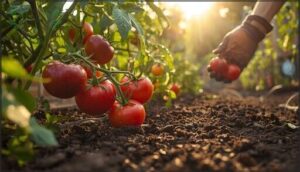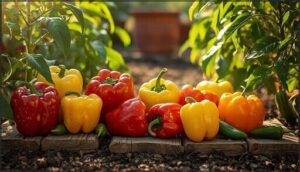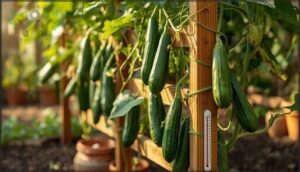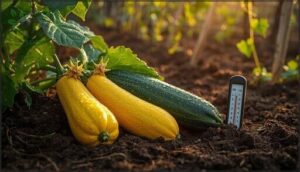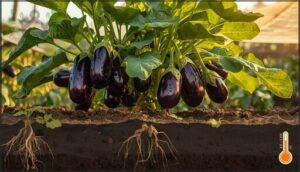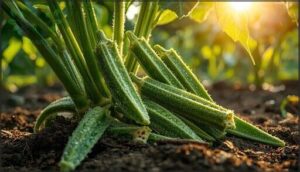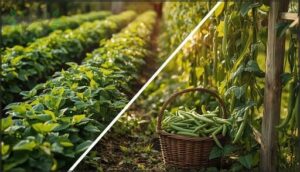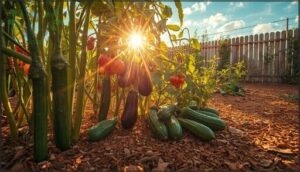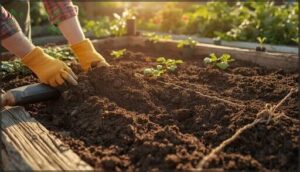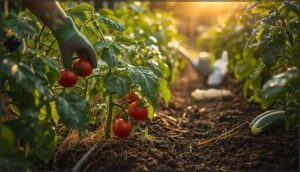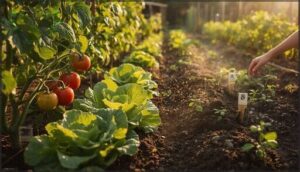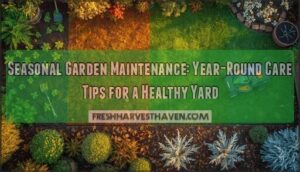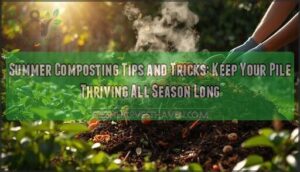This site is supported by our readers. We may earn a commission, at no cost to you, if you purchase through links.
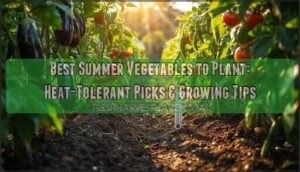
Most gardeners don’t realize that soil temperature matters more than calendar dates when planting summer vegetables. Drop a tomato transplant into 55°F soil and you’ll watch it sulk for weeks, but wait until the ground hits 60°F and that same plant will explode with growth.
The difference between mediocre harvests and abundant yields often comes down to matching your crops to your climate’s actual conditions—not just following generic planting guides. Summer vegetables range from heat-worshipping okra that thrives above 95°F to temperamental eggplants that refuse to set fruit outside their narrow comfort zone.
Getting the timing right, choosing varieties bred for your region’s heat levels, and understanding each crop’s soil preferences puts you in control of your harvest.
Table Of Contents
- Key Takeaways
- Top Summer Vegetables for Your Garden
- Heat-Tolerant Vegetables for Hot Climates
- Soil Preparation and Planting Guidelines
- Watering, Feeding, and Maintenance Tips
- Succession Planting for Extended Harvest
- Frequently Asked Questions (FAQs)
- What vegetables can you grow in summer?
- Do summer vegetables grow well in the Sun?
- Can you grow summer vegetables in your yard?
- Which vegetables grow best in the fall?
- Can you plant vegetables in July and August?
- Can you plant vegetables in hot summer?
- Can you grow vegetables in summer?
- What vegetables grow well in summer?
- What can I plant in my Garden in summer?
- What vegetables can you grow in winter?
- Conclusion
Key Takeaways
- Soil temperature above 60°F matters far more than planting dates—drop tomatoes into cold ground and they’ll stall for weeks, but warm soil triggers explosive growth in heat-loving crops like okra, peppers, and eggplant.
- Heat-tolerant cultivars like Solar Fire tomatoes and Annie Oakley II okra maintain fruit set above 95°F through genetic advances, delivering 17-29% higher yields than traditional varieties during summer heat waves.
- Succession planting every two weeks with fast-maturing crops like radishes (22-28 days) and bush beans (50-60 days) boosts total output by 30-45% compared to single sowings, keeping your harvest rolling continuously.
- Morning watering between 6-10 a.m. slashes fungal disease incidence by 19-35% by allowing foliage to dry before evening, while proper spacing cuts leaf disease by 21% and prevents the yield losses that come from crowding.
Top Summer Vegetables for Your Garden
Summer heat doesn’t have to limit what you grow—it just means you need to pick the right players for your garden lineup.
Some vegetables absolutely thrive when temperatures climb, rewarding you with generous harvests while others wilt under pressure.
Here’s your roster of proven summer champions that won’t back down when the sun turns up the intensity.
Tomatoes: Varieties and Growing Requirements
Tomatoes reign foremost in summer vegetable gardening—but choosing the right variety and nailing your growing conditions makes all the difference. You need soil pH between 5.8 and 6.8, at least six hours of direct sunlight daily, and warm soil above 60°F before transplanting. New heat-tolerant cultivars like Solar Fire and Heatmaster thrive above 95°F, revolutionizing tomato breeding for hotter climates. Understanding tomato varieties is vital for a successful harvest.
Key considerations for success:
- Variety selection: Choose disease-resistant hybrids like “Improved Garden Gem” for reliable fruit quality, or go bold with heirloom “Cherokee Purple” for outstanding flavor
- Soil preparation: Enrich your beds with organic matter and guarantee excellent drainage—loamy soil dramatically boosts yield potential
- Heat tolerance: Plant cultivars bred for high-temperature performance if you’re battling scorching summers; older varieties may drop flowers above 90°F
- Disease management: Look for ToBRFV-resistant varieties released in 2025 to sidestep devastating viral outbreaks that previously required total crop destruction
Peppers: From Sweet Bell to Spicy Varieties
Peppers bring bold flavor and fire to your summer garden, whether you’re chasing sweet bell varieties or venturing into scorching spice levels. Heat tolerance is exceptional—these summer vegetables thrive alongside tomatoes in full sun and well-draining soil.
You’ll harvest 125 pounds per hundred-foot row with bell peppers, even more with cubanelle types. The Scoville Scale measures capsaicin content: habaneros reach 350,000 units while ghost peppers top a million. Understanding the chili pepper varieties is essential for managing heat in your garden.
Cucumbers: Trellising and Care Tips
Cucumbers climb fast when you build a trellis between 6 and 8 feet tall—trellised cucumbers yield 24% more than ground-grown varieties. Space plants 12 to 18 inches apart along the base for airflow. Prune vines at 5 feet to keep harvests manageable.
Direct sow when soil temperature hits 70°F, then watch these heat-tolerant summer vegetables take off vertically.
Summer Squash and Zucchini Basics
Right alongside those climbing vines, summer squash and zucchini let you break free from grocery store limits—these fast-growing vegetable varieties need 65°F soil and deliver harvests in just 50 to 65 days.
Plant zucchini varieties for serious nutrition—17 calories and 194mg potassium per 100g serving fuel your summer vegetable gardening.
Watch for squash bugs during summer harvest, then practice crop rotation to outsmart garden pests season after season.
Eggplant: Climate Considerations and Care
Unlike most summer vegetable gardening staples, eggplant varieties demand serious heat—these heat-tolerant vegetables won’t set fruit below 68°F or above 95°F, so you’ll need strategic climate tolerance planning.
Master soil preparation with well-draining beds, then fight heat stress through morning watering and shade cloth during extreme spells.
Smart fertilizer management with nitrogen-rich feeds every three weeks keeps your eggplant thriving through summer’s toughest gardening challenges.
Okra: a Heat-Loving Staple
Okra thrives where other heat-tolerant vegetable options surrender—it’s your secret weapon for summer vegetable gardening success when temperatures soar past 95°F.
This powerhouse among summer vegetables delivers impressive yields of 9.81 tons per hectare globally while offering outstanding okra nutrition: 26% daily vitamin C and loads of fiber.
Choose from diverse okra varieties suited to your region, and you’ll discover endless okra recipes all season long.
Bush and Pole Beans for Continuous Harvest
Transform your garden into a nonstop bean factory by mastering the art of Bush beans versus pole varieties—each brings its own harvest magic to the table.
- Bush Bean Yields: Expect 4–5 pounds per 10-foot row with concentrated 2–3 week harvests, perfect for canning.
- Pole Bean Structures: Set up trellises for 8-pound yields per row—double the production through frost.
- Harvest Timing: Pick immature pods frequently to trigger more flowering and extend your bounty.
- Bean Variety Selection: Plant disease-resistant cultivars like Blue Lake or Maxibel for reliable seed germination and continuous summer squash-style productivity.
Succession planting Bush beans every two weeks keeps fresh pods coming all season, rivaling other fast-growing vegetable varieties. These heat-tolerant vegetable options make planting vegetables in summer a breeze—you’ll never face an empty harvest basket again.
Heat-Tolerant Vegetables for Hot Climates
When summer heat climbs past comfortable and into scorching, most vegetables throw in the towel—but not all of them. Some crops actually laugh in the face of triple-digit temperatures and keep producing like champions.
When summer heat climbs past comfortable into scorching, some crops actually laugh in the face of triple-digit temperatures and keep producing like champions
Let’s look at the varieties that won’t just survive your hottest months but will thrive through them.
Selecting Varieties for High-Temperature Success
Not all vegetables buckle under brutal heat—some thrive in it. Genetic advances have slashed development time for heat-tolerant vegetable options by over 30%, giving you access to cultivars like Solar Fire and Heatmaster tomatoes that maintain fruit set above 95°F.
Fast-growing vegetable varieties with enhanced climate adaptation and crop resilience let you reclaim summer gardens once ruled by heat waves, no compromises needed.
Swiss Chard and Malabar Spinach as Lettuce Alternatives
Lettuce wilts when summer heat hits, but you don’t have to give up fresh leafy greens. Swiss chard and Malabar spinach keep producing through temperatures that kill traditional salad crops, thriving between 68-95°F.
Chard delivers over 477% of your daily vitamin K per cooked cup, while Malabar spinach brings 30-40 mg of vitamin C per 100 g—both outpacing lettuce nutritionally and standing strong when heat waves roll in.
New Heat-Resistant Tomato Cultivars
When temperatures climb past 95°F, standard tomatoes fail—but you can break that pattern with new heat-resistant cultivars. Varieties like Heatmaster, Solar Fire, and Stupice maintain fruit set above 95°F through enhanced pollen viability, while genomic breeding advances thermotolerance in cultivars such as Tamaulipas and Empress.
These heat-tolerant vegetables deliver yields 17-29% higher than traditional types during summer heat waves.
Melons: Water and Fertilizer Needs
Your heat-resistant tomatoes won’t deliver without proper companions—and watermelon thrives alongside them when you nail water and fertilizer application.
Apply 1–2 inches weekly through drip irrigation for water efficiency, monitoring soil moisture in the top 6 inches.
Front-load nitrogen at 120 lbs per acre before fruit set, then boost potassium to drive nutrient uptake and sweetness during peak summer heat.
Regional Variety Selection for Optimal Growth
Your climate zone dictates which heat-tolerant vegetables will actually thrive—not just survive. In Zone 8, pair heat-tolerant vegetable varieties like Skyway 687 tomatoes with Annie Oakley II okra for reliable fruit set above 90°F. Regional adaptation matters more than wishful thinking:
- Batavian lettuce (Muir, Nevada) resists bolting past 85°F
- Caraflex cabbage survives midsummer heat events in 68 days
- Marketmore 76 cucumbers fight powdery mildew in humid zones
Match soil types and heat wave-tolerant plants to your actual conditions.
Soil Preparation and Planting Guidelines
Before you drop a single seed, you need to set the stage for success. Getting your soil, sun exposure, and spacing right from the start means stronger plants and bigger harvests all summer long.
Here’s what you need to nail down before planting day arrives.
Sunlight Requirements: Full Sun Vs. Partial Shade
Your crop placement strategy starts with matching sunlight hours to each vegetable’s appetite for light. Most fruiting summer vegetables—tomatoes, peppers, cucumbers—demand 6 to 8 hours of direct sun to thrive, while leafy greens and root crops adapt to partial shade with 3 to 6 hours. Photosynthesis rates and yields drop sharply without adequate light intensity, so choose heat-tolerant vegetable options wisely based on your site’s exposure.
| Vegetable Type | Sunlight Hours Required | Shade Tolerance |
|---|---|---|
| Fruiting (tomatoes, peppers, melons) | 6–8+ hours | Low |
| Root crops (beets, carrots, radishes) | 4–6 hours | Moderate |
| Leafy greens (lettuce, chard, spinach) | 3–4 hours | High |
| Beans and peas | 4–6 hours | Moderate |
Soil Drainage and Organic Matter Enrichment
Once you’ve pinpointed your sunny spots, turn your attention to what lies beneath: soil drainage and organic matter enrichment. Poor drainage drowns roots and invites disease, while the right organic content fuels fertility and unlocks nutrients. Here’s how to nail both:
- Aim for 3–5% organic matter—any higher risks nutrient burn and stunted crops
- Mix compost or shredded leaves into clay soils to boost aeration and water movement
- Blend perlite at 10–20% for instant air pockets in compacted beds
- Avoid waterlogging beyond 48 hours to prevent root death and ethylene stress
- Test annually; urban gardens often exceed 10%, harming peppers and sensitive vegetables
Master soil preparation now, and you’ll set the stage for explosive summer yields.
When to Direct Sow Vs. Transplant
Should you start seeds outdoors or give them a head start indoors? Crop selection and transplant timing drastically shift your harvest window. Root vegetables demand direct sowing to prevent shock, while tomatoes and peppers thrive in a controlled nursery environment. Here’s your roadmap:
| Crop | Method | Best Timing |
|---|---|---|
| Tomatoes, Peppers, Eggplant | Transplant | Start indoors 6–8 weeks before last frost; transplant 1–2 weeks after |
| Beans, Squash, Okra | Direct Sowing | Sow 1–2 weeks after last frost when soil warms to 60°F+ |
| Carrots, Beets, Turnips | Direct Sowing | Sow anytime after frost; avoid transplanting to prevent root deformation |
| Lettuce, Chard | Either | Transplant for early harvest; direct sow every 2 weeks for succession |
| Cucumbers, Melons | Direct Sowing (preferred) | Wait for warm soil (70°F+); transplant only for short-season gains |
Transplants significantly reduce establishment time and triple survival rates. For example, onions yielded 36.3 t/ha with transplants, maturing 31 days earlier, compared to 19.5 t/ha without. Fast-growing vegetables like radishes and bush beans excel with direct sowing, while heat-tolerant varieties (Solar Fire tomatoes, cubanelle peppers) benefit from controlled seedling care. When growing vegetables from seeds, match your method to the crop’s root structure and your frost dates.
Soil preparation is crucial; vegetable planting guides show that transplants dominate early yields, capturing 46–50% of harvests in the first month, versus 13–38% for direct-seeded crops.
Spacing and Support Structures for Vining Plants
Give your vining vegetables room to breathe—crowding slashes yields by up to 30% and invites disease. Vertical gardening with proper anchoring materials transforms chaos into control:
- Summer squash: Space 18–24 inches apart; wider rows cut leaf disease by 21%
- Cucumbers: 8–10 inches between plants with nylon mesh trellises boosts harvests 25%
- Peppers and okra: 18–24 inches for airflow
- Vine training: Anchor anchors 12 inches deep before planting to avoid root damage
Ideal spacing isn’t negotiable—it’s your frontline disease prevention strategy.
Mulching to Conserve Moisture and Cool Soil
Without proper moisture conservation, your summer gardening efforts can evaporate—literally. Mulch materials slash irrigation frequency by half while dropping soil temperature 2–5°C during brutal heatwaves. Organic matter boosts water retention up to 35%, and heat-tolerant vegetable options thrive when roots stay cool.
Proper mulching during soil preparation slashes weeding labor 22% and extends watering intervals by seven days.
| Mulch Type | Soil Temperature Impact |
|---|---|
| Straw | Reduces 2–5°C during peak heat |
| Wood Chips | Lowers fluctuations up to 6°C |
| Newspaper + Straw | Maintains 1.7°C cooler soil |
| Grass Clippings | Increases potassium 14–19% |
| Plastic (Red) | Boosts tomato yields 12–20% |
Watering, Feeding, and Maintenance Tips
Planting your summer vegetables is just the beginning—keeping them thriving through the heat takes a smart maintenance game plan. You’ll need to nail your watering timing, feed your heavy feeders right, and stay ahead of pests before they wreak havoc.
Let’s break down the essential care strategies that’ll keep your garden producing all season long.
Morning Watering to Reduce Disease Risk
Timing your irrigation like a pro is one of the smartest disease prevention moves you can make. Watering schedules that favor morning hours—between 6:00 and 10:00 a.m.—drastically cut leaf wetness duration and give foliage time to dry before evening, slashing fungal control headaches by up to 40%.
Here’s why irrigation timing matters for your heat-tolerant vegetable options:
- Morning watering lets leaves dry fast, reducing pathogen germination windows and keeping blight at bay.
- Evening watering cranks up humidity overnight, giving fungal spores the prolonged moisture they crave—bad news for tomatoes and cucumbers.
- Early irrigation lowers disease incidence by 19–35% across summer crops, protecting your hard-won yields.
These summer gardening tips aren’t just theory—they’re field-tested strategies that keep your garden thriving when heat and humidity conspire against you.
Fertilizer Schedules for Heavy Feeders
Heavy feeders like tomatoes and peppers demand fertilization every 3–4 weeks to keep nutrient uptake cranking through peak summer growth—though sandy soils call for biweekly rounds due to leaching. Balanced NPK approaches boost yields by 18–33%, while crop rotation with legumes slashes nitrogen needs by 35–40 lbs/ac. These summer gardening tips maximize fertilizer efficiency and release the full potential of your heat-tolerant vegetable options.
| Soil Type | Fertilization Frequency |
|---|---|
| Clay-based | Every 4–6 weeks |
| Sandy | Every 2–3 weeks |
| Standard loam | Every 3–4 weeks |
Providing Shade for Heat-Sensitive Crops
Shade cloth materials—especially 30–35% polyethylene nets—slash ambient temperatures by up to 5°C, handing you direct control over crop microclimate and heat stress mitigation when summer heat hits hard. These temperature control strategies transform growing conditions for heat-tolerant vegetable options like lettuce and peppers, extending your harvest window by two full weeks.
Summer gardening tips for effective shade structure installation:
- Mount 30% shade over tomatoes and cucumbers; 60% for leafy greens
- Choose red or pearl shade cloth materials for enhanced fruiting-crop performance
- Combine shade with drip irrigation to cut water needs 20–30%
- Install removable frames—roll up heat-tolerant vegetables’ shade when temps drop
- Pair reflective nets with mulch to reduce heat stress indicators 31%
Monitoring for Pests and Disease Early
Your shade structures won’t mean much if pests and diseases ambush your crop. Weekly scouting—the cornerstone of integrated management—catches infestations before they spiral, reducing losses by up to 40%. Early intervention pays off: farms practicing crop monitoring report yield improvements averaging 13–27% compared to reactive gardening tips.
Here’s your reconnaissance checklist:
| Target | Early Detection Signs |
|---|---|
| Bacterial leaf spot | Water-soaked lesions on peppers and tomatoes |
| Septoria leaf spot | Lower-leaf yellowing with dark spots |
| Diamondback moth | Windowpane feeding holes in cabbage |
| Eggplant borers | Wilting shoots, entry holes near stems |
For heat-tolerant vegetables like okra and peppers, inspect the undersides of leaves—most pest colonies hide there. Sticky traps reveal flying invaders; 85% of growers use them for pest detection. Disease prevention beats cure: hyperspectral imaging now catches tomato pathogens before symptoms appear, but your eyes work fine. Scout Monday mornings, catch problems small, and you’ll own your summer harvest—no compromises, no catastrophic failures.
Harvesting at Peak Ripeness for Best Flavor
Scouting reveals when, but ripeness indicators tell you now. Harvest timing matters: pick tomatoes at °Brix 5.5+ for peak flavor profiles, and you’ll lock in 35% more antioxidants than early pulls.
Summer vegetables harvested at dawn retain 20–30% longer shelf life. For heat-tolerant vegetable options like peppers and fast-growing vegetable varieties such as cucumbers, firmness and deep color signal nutrient retention.
Crop monitoring plus sharp eyes = maximum flavor.
Succession Planting for Extended Harvest
If you want your summer garden to keep producing long after that first harvest, succession planting is your game plan. Instead of planting everything at once and watching it all ripen in the same week, you’ll stagger sowings and choose quick-turnover crops that keep the bounty rolling.
Here’s how to orchestrate a continuous harvest from early summer straight through to fall.
Re-Sowing Every Two Weeks for Continuous Production
Consistently resowing summer vegetables every two weeks is your ticket to harvest scheduling freedom and yield optimization. This continuous production approach works brilliantly with heat-tolerant vegetable options like lettuce, arugula, and greens—especially when you stagger planting based on soil temperature and resowing intervals.
You’ll boost total output by 30–45% compared to single sowings, keeping fresh crops rolling in while smart crop rotation prevents pest buildup and maintains soil health.
Fast-Maturing Crops: Radishes and Bush Beans
When you want harvest scheduling freedom on your terms, radishes and bush beans are your go-to allies. Radishes reach maturity in just 22–28 days, while bush beans deliver in 50–60 days, making them perfect for succession planting every 7–14 days.
Here’s what makes them unbeatable for summer gardening tips:
- Fast maturation cycles minimize wait time between harvests
- Heat-tolerant vegetable options that thrive in full sun
- Simple crop rotation that maintains soil health
- Multiple radish varieties like ‘Cherry Belle’ for diverse flavors
- Bush bean care requires minimal effort with maximum yield
These fast-growing vegetable varieties give you control over continuous production all season.
Starting Fall Crops in Mid to Late Summer
Midsummer Sowing unlocks your growing rebellion against single-season limits. Count back 12–14 weeks from your first frost date to nail Fall Crop Planning timing.
Heat-tolerant vegetable options like kale, arugula, and beets thrive when started now, while shortening daylight demands strategic Succession Strategies.
Turn over spent soil, add balanced fertilizer, and mulch heavily—this Soil Preparation transforms summer gardening ideas into unstoppable fall yields, extending the growing season on your terms.
Understanding Days to Maturity for Planning
Maturity Periods drive your Crop Scheduling power—radishes bolt in 20 days, bush beans in 55, eggplants in 60. Heat-tolerant vegetable options and fast-growing vegetable varieties need different Harvest Timing windows. Count back from frost, add a buffer week, then plant backward for Seasonal Planning victory.
Summer gardening tips reveal degree-day models beat guesswork, trimming error margins on Growth Stages across all heat-tolerant vegetables you’ll master.
Root Vegetables: Beets, Carrots, and Turnips
Root crops like beets, carrots, and turnips won’t thrive in Florida’s scorching summer, but elsewhere they’re direct-seed champions when soil hits 50°F. New England averages 6,860 lb/acre for beets and 11,220 for carrots under solid soil preparation—pH above 7 for mineral beds unlocks that yield.
- Beet nutrition soars when you maintain consistent moisture through those critical 70-day growth windows
- Carrot diseases collapse under nematode-resistant summer varieties and sandy-loam drainage
- Turnip recipes demand 3–4 tons per acre of crisp roots—achieve it with proper root crop storage at harvest
Frequently Asked Questions (FAQs)
What vegetables can you grow in summer?
You can grow tomatoes, peppers, cucumbers, summer squash, eggplant, okra, and beans—all thriving in heat.
Fast-growing vegetable varieties like radishes extend your summer harvest, while heat-tolerant vegetable options handle scorching days with surprising resilience.
Do summer vegetables grow well in the Sun?
Absolutely—most summer vegetables thrive in full sun, needing 6–8 hours daily for strong photosynthesis rates and maximum vegetable yield.
Heat-tolerant options like okra and peppers excel, boosting soil temperature and delivering bountiful harvests.
Can you grow summer vegetables in your yard?
Your yard is your canvas, your soil is your medium, your harvest is your reward. With proper soil testing, climate zone awareness, and heat-tolerant vegetable options, you’ll transform any yard space into a thriving summer garden refresh.
Which vegetables grow best in the fall?
Cool season crops like broccoli, cabbage, spinach, and kale dominate your fall harvest.
Root crops—carrots, beets, radishes, and turnips—thrive in cooler soil, while fast-growing brassicas and arugula deliver quick autumn gardening wins.
Can you plant vegetables in July and August?
Yes, you can plant vegetables in July and August through succession sowing.
Summer planting focuses on fast-growing vegetable varieties and heat-tolerant vegetables like squash, basil, beans, and radishes that thrive in warm weather crops conditions.
Can you plant vegetables in hot summer?
You can plant vegetables in hot summer if you choose heat-tolerant options like okra, eggplant, and peppers.
Success hinges on selecting crop-resilient varieties, maintaining soil temperature, and practicing smart water conservation for your summer harvest.
Can you grow vegetables in summer?
Absolutely—summer’s your prime growing window. Focus on heat-tolerant vegetable options and fast-growing varieties that thrive in garden soil temperatures above 65°F.
Master summer harvest timing, pest control, and crop rotation for maximum yields.
What vegetables grow well in summer?
Summer harvest champions—tomatoes, peppers, cucumbers, squash, and beans—thrive in heat. These heat-tolerant vegetables handle soil temperatures above 60°F beautifully, rewarding your garden planning with continuous crops when you match varieties to your climate’s heat resilience demands.
What can I plant in my Garden in summer?
You can plant tomatoes, peppers, beans, squash, and cucumbers once soil temperatures hit 60–70°F.
Focus on heat-tolerant vegetable options and fast-growing varieties for continuous summer harvest with proper garden planning and crop rotation maintenance.
What vegetables can you grow in winter?
When frost blankets the land like a Dickensian scene, you can still harvest kale (withstanding -10°F), winter radishes, and turnips.
Cold-hardy greens, frost-tolerant crops like beets, and carrots sweeten beautifully under snow.
Conclusion
You don’t need years of experience to grow the best summer vegetables—just a willingness to ditch the generic advice and tune into your soil’s actual temperature.
Once you stop gambling on calendar dates and start matching heat-loving crops to your climate’s reality, mediocre harvests become a thing of the past.
Your garden will reward bold, informed decisions with baskets of peppers, tomatoes, and squash that prove you were always in control.
- https://www.lsuagcenter.com/topics/lawn_garden/home_gardening/vegetables/expected-vegetable-garden-yields
- https://www.gothicarchgreenhouses.com/what-to-grow-in-your-greenhouse-this-summer-top-picks-for-2025
- https://ers.usda.gov/sites/default/files/_laserfiche/outlooks/111478/VGS-375.pdf?v=41325
- https://media.neliti.com/media/publications/620213-climate-resilient-crops-innovations-in-v-f659c4fb.pdf
- https://pmc.ncbi.nlm.nih.gov/articles/PMC9873721/

